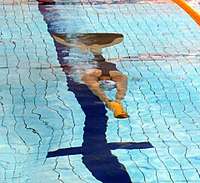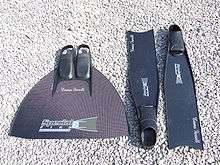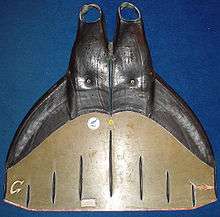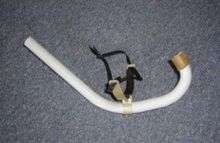Finswimming
Finswimming is an underwater sport consisting of four techniques involving swimming with the use of fins either on the water's surface using a snorkel with either monofins or bifins or underwater with monofin either by holding one's breath or using open circuit scuba diving equipment. Events exist over distances similar to swimming competitions for both swimming pool and open water venues. Competition at world and continental level is organised by the Confédération Mondiale des Activités Subaquatiques (CMAS). The sport's first world championship was held in 1976. It also has been featured at the World Games as a trend sport since 1981 and was demonstrated at the 2015 European Games in June 2015.
 Finswimming with monofin | |
| Highest governing body | CMAS |
|---|---|
| Characteristics | |
| Contact | no |
| Mixed gender | Yes, but usually in separate events |
| Type | Aquatic, indoor, outdoor |
| Equipment | diving mask, snorkel, fins, open circuit scuba set |
| Venue | swimming pool, open water |
| Presence | |
| Country or region | International |
| Olympic | No |
| World Games | 1981 – present |
Rules and description of the sport
Competitors
Competitors are described within the International Rules as 'swimmers' rather than as finswimmers or divers.[1]
Classes of competition
Competition is divided in two classes: swimming pool and long distance (also called open water).[2]
A swimming pool must be 50 m long by 21 m wide and 1.8 m deep, i.e. an Olympic-size swimming pool (also known as a long course pool) suitable for the holding of swimming races for either the Olympic Games and a FINA world championships.[2][3] The International Rules do not permit the use of 25m length pools (known as short course) although these are used in regional and national competition.[4]
Long distance sites include both the sea and natural water bodies such as freshwater rivers and lakes. Site selection criteria include 'low current and tides' and water quality 'appropriate for swimming' as certified by a local authority. The site, when in use for competition, will be marked by buoys, patrolled by safety boats and will have observation points (or additional boats) for judges to oversee any turns present in the course.[2]
Techniques

Surface finswimming
Surface finswimming (also known by its acronym, SF) is swimming on the surface of the water using mask, snorkel, and monofins. SF races are held for distances of 50, 100, 200, 400, 800, 1500, 4 × 50 mix relays (2 mens, 2 womens), 4 × 100 relays and 4 × 200 relays (meters) in swimming pools and over various long distances in the open water environment. Swimmers must remain on the surface of the water at all times for the duration of the race except when starting or make a turns at the end of a swimming pool where an immersion over a distance of 15m is permitted.[1]
Apnoea finswimming
Apnoea finswimming (also known by its acronym, AP, and as apnoea or apnea) is underwater swimming in a swimming pool using a mask, monofin and holding one's breath. AP races are held for the distance of 50m. A swimmer's face must be immersed for the duration of the race otherwise he/she risks disqualification. AP races are not conducted in open water for 'safety and security reasons'.[1]
Immersion finswimming with breathing apparatus
Immersion finswimming with breathing apparatus (also known by its acronym, IM, and as immersion) is underwater swimming using mask, monofin and underwater breathing apparatus conducted in a swimming pool. While there are no requirements on how a breathing apparatus is carried, it cannot be exchanged or abandoned during a race. IM races are held for distances of 100 and 400 m. A swimmer's face must be immersed for the duration of the race or risk disqualification. IM races are not conducted in open water for 'safety and security reasons'.[1] Historically, IM swims were conducted in open water up to distances of 1000m.[5]
Bi-fins
Bi-fins (also known by its acronym, BF or as 'stereo-fins') is swimming on the surface of the water with mask, snorkel and a pair of fins using a crawl style. BF races are held for distances of 50, 100, 200, 400 and 4 × 100 mix relays (2 mens, 2 womens) in swimming pools and over various long distances in the open water environment such as 4 km and 6 km. It is reported that BF was introduced in 2006 to provide the opportunity for competition by swimmers who cannot afford to purchase a set of monofins. Swimmers must remain on the surface of the water at all times for the duration of the race except when starting or make a turns at the end of a swimming pool where an immersion of a distance of 15m is permitted.[1][6]
Equipment


Finswimming which is often compared to sports swimming[7] differs from that sport in the use of masks, fins, snorkels and underwater breathing apparatus. This reflects the sport's origins in the underwater diving techniques of snorkelling, breath-hold diving and open circuit scuba diving.
Apart from requiring the use of a mask for protection of the eyes and for the ability to see underwater, the international rules have no requirements regarding selection. Centre-mounted snorkels (also known as front snorkels) are the only type approved for use subject to meeting minimum and maximum requirements in tube length and internal diameter. Fins are also regulated by international rules. Monofins have a maximum size which can be checked by the use of a template while bi-fins must be one of the brands certified (i.e. homologated) by CMAS.[8]
Underwater breathing apparatus is restricted to open circuit scuba using compressed atmospheric air as the breathing gas. The use of oxygen enriched mixtures is forbidden. Cylinders are limited by maximum cylinder pressure rating of 200 bar and a minimum cylinder capacity of 0.4 litres. While there are no requirements for regulators, swimmers appear to be free to modify these to remove any unnecessary parts.[8]
Garments such as swimsuits, swim caps and wetsuits, and the use of logos printed on these garments and the equipment is also subject to the requirements of the international rules.[8]
Age groupings and associated restrictions
The following age groupings and associated restrictions for both men and women are mandated by the International Rules.[9]
| Age group title | Age group code | Age range | Restrictions |
|---|---|---|---|
| Senior | A | 18 years & over | No restrictions |
| Junior | B | 16–17 years | No restrictions |
| Junior | C | 14–15 years | Maximum openwater swim of 8 km |
| Junior | D | 12–13 years | Maximum openwater swim of 6 km Maximum AP distance of 25m |
| Junior | E | less than 11 years | Known as the 'pre-competition group'; national rules apply for this age group as there is no international competition for this group. |
| Master | V0 | 25–34 years | No restrictions |
| Master | V1 | 35–44 years | No restrictions |
| Master | V2 | 45–54 years | No restrictions |
Origins and history
The sport developed in Europe following the ready availability of the first rubber fins during the 1930s.[10] Luigi Ferraro, Italian diving pioneer, is reported as organising the first fin-swimming competition in the sea during 1951 followed by a 100 kilometres (62 miles) ocean swim in 1955.[6] The first competition in the Soviet Union was held during 1958.[11]
The first European Championship which was a multi sport event involving both finswimming and underwater orienteering was held under the title of the First European Championship of Subaquatics Technical at Angera, Italy in August 1967. The specific finswimming events were races over the distances of 40m and 1000m which are reported as using either surface swimming techniques or respectively apnoea and immersion techniques. In 1969, the first European Finswimming Championship to be separate of underwater orienteering was held in Locarno, Switzerland.[11][12]
The first World Championships were held in Hanover, Germany during 1976 followed by the inclusion of the sport in the inaugural World Games in Santa Clara, California, USA during 1981. In 1988, the first World Long Distance Championship was held in Paris, France followed in 1989 by the first World Junior Championship in Dunaújváros, Hungary.[11][13][14]
The arrival of the monofin in the early 1970s lead to the breaking of all world records by the end of the decade due to the improved performance possible when used in lieu of bi-fins.[6]
In 2007, the first Bi Fin races using CMAS homologated fins were held.[11]
Sporting appeal and training
Appeal
The main appeal of finswimming is reported by some as being the speed that a swimmer can reach.[7] The world record for the men's 50 m freestyle (long course) in sports swimming (see World records in swimming), is 20.91 seconds (by César Cielo of Brazil). In finswimming it is 13.85 seconds (for 50 m apnoea by Pavel Kabanov of Russia) (see World records in finswimming). This is a 50% increase in speed over sports swimming.
One of the great appeals of finswimming is that finswimmers do not need to be good sports swimmers. Indeed, there is some evidence that top flight sports swimmers may make poorer finswimmers than well-trained finswimmers (see below).
Training
Unlike most sports swimming training programmes, finswimming training tends to be far more specific and more like systems used for track running in athletics. In addition, finswimming training tends to have more dry-side work, including a huge amount of core stability (as core strength), plyometrics and weight training.
It has been recorded that sports swimmers tend to approach finswimming with preconceptions on technique, which can limit their success.[15][16][17]
Governing body
The governing body is the CMAS Finswimming Commission.[18]
Its role includes the upgrading of the rules of competition when required, keeping of records for CMAS championships, the World Games and these of national federations where these match or exceed records achieved at international level, and the maintenance of the CMAS World Ranking which is a listing of the best performing senior and junior men and women from both the most recent Finswimming World Championships and the rounds of the World Cup. It also assists the CMAS Board of Directors and others organising competitions organised under the auspices of CMAS.[19]
As of June 2015, national federations in the following countries and territories have affiliated with the Commission: Algeria, Argentina, Armenia, Austria, Australia, Belgium, Belarus, Canada, Cameroon, Cape Verde, Chile, Colombia, Cuba, China, Croatia, Cyprus, Czech Republic, Denmark, Ecuador, Egypt, Estonia, Finland, France, Germany, Great Britain, Greece, Hungary, Hong Kong, Indonesia, Italy, Japan, Jordan, Kazakhstan, Kenya, Korea, Kuwait, Kyrgyz Republic, Lebanon, Luxembourg, Libya, Mexico, Marianas, Montenegro, Netherlands, Palestine, Peru, Philippines, San Marino, Saudi Arabia, Serbia, Singapore, Slovakia, Slovenia, Spain, Switzerland, Syria, Russia, Tunisia, Turkey, Taiwan, Thailand, United Arab Emirates, United States of America, Venezuela and Vietnam.[20]
Competition at international level
CMAS competitions
As of 2007, CMAS directly oversees the following four competitions at international level: the World Championship, Continental Championships, the World Cup and the CMAS Junior Trophy.[21]
World Championship
The World Championship is held every two years in odd-numbered years for senior swimmers starting with the year 2007 and in even-numbered years for junior swimmers starting with the year 2008. Pool competition held over five days while open water competition is held over a maximum of three days.[22]
World Cup
This is an annual event which was first held in 2006 and consists of a minimum of three rounds including a final all known as meetings which are attended by swimmers from clubs affiliated to a CMAS national federation. Races are held in both swimming pool and open water sites for individuals and clubs in the age groupings of senior and junior for both male and female.[23]
CMAS Junior Trophy
This is an annual swimming pool-based event for junior national teams for both male and female swimmers.[24]
Continental championships
Continental championships which are conducted in an identical manner to the world championships require a minimum of five countries from a continental body such as Africa, America, Asia, Europe and Oceania as defined by the International Olympic Committee (IOC). The Continental championships are held every two years in odd-numbered years for senior swimmers starting with the year 2008 and in even-numbered years for junior swimmers starting with the year 2007.[22][25] The European Championships have run since 1967 and have been held 21 times. Asian Finswimming Championships is reported to have been held 13 times with the first being held in 1989 and the most being held during 2012 in Da Nang, Vietnam.[26]
Other CMAS-aligned events
There have been three Pan-American Championships, starting in 1993, with the last being held in 2001 in Cali, Colombia. There have also been five "Arab Zone" Championships, the last was held in 2003 (in Beirut, Lebanon).
World Games
Finswimming has featured at the World Games as a trend sport since the inaugural games held during 1981. Participation is reserved for the best swimmers from the CMAS World Ranking and the best relay teams as selected by the CMAS Finswimming Commission.[27][28]
Other multi-sport events
Finswimming has appeared at multi-sport events such as the following: Asian Indoor Games,[29] Bolivarian Games,[30] Southeast Asian Games,[31] World Corporate Games from 1998 to 1992, and the World Scholar-Athlete Games.[32] The sport was also demonstrated at the 27th Summer Universiade in July 2013 and at the 2015 European Games in June 2015.[33][34]
Olympic Games
As of 2011, no finswimming competition or demonstration has been held at an Olympic Games.[35] CMAS which is recognised by the IOC as the international sports federation for underwater sports was so recognised in 1986 solely on the basis of finswimming.[36][37] In 1999, finswimming was reported as being considered for inclusion in the 2004 Summer Olympics in Athens, Greece.[38] In 2002, the IOC considered underwater sports which includes finswimming as one of the sports to be added to the programme of the 2008 Summer Olympics in Beijing, China, but decided to decline admission to it and eight other sports on the basis of:[39]
Statistics reviewed on federation affiliation, nations competing in major events and broadcast and press coverage of major events for most requested sports did not indicate a higher level of global participation and interest than sports currently in the Programme, and therefore could not be considered to bring additional value.
See also
Competitions
- Finswimming World Championships – International event for the underwater sport of finswimming
- Finswimming at the World Games – A trend sport at the World Games
- Finswimming at the 2007 Asian Indoor Games
- Finswimming at the 2009 Asian Indoor Games – Competition held in Mỹ Đình National Aquatics Sports Complex, Hanoi, Vietnam
- Finswimming at the 2009 Southeast Asian Games
- Fin swimming at the 2011 Southeast Asian Games
- Texas Open Finswimming Invitational – An open finswimming competition held in Texas since 1999
- Underwater sports at the 2013 Bolivarian Games – Finswimming, free-diving and spearfishing events
Finswimming by country
- Finswimming in Australia – Water sport
- Finswimming in the United Kingdom – Practice of the sport and supporting infrastructure
- Finswimming in the United States – Competitive swimming using swimfins in the US
Competitors and organisations
- Joel Armas – Cuban finswimmer
- Valentina Artemyeva – Russian swimmer
- Peppo Biscarini – Italian and American swimmer, freediver, and actor
- Misty Hyman – American swimmer
- Shavarsh Karapetyan
- Flori Lang – Swiss swimmer
- Vitalina Simonova – Russian swimmer
- Texas Finswimming Association – Official governing body for competitive and recreational finswimming in Texas
Records
References
- FINSWIMMING - CMAS RULES VERSION 2012/03 In force as from January 1, 2013 (BoD179 - 22/11/2012). Rome: Confédération Mondiale des Activités Subaquatiques. 2012. pp. 2–3.
- FINSWIMMING - CMAS RULES VERSION 2012/03 In force as from January 1, 2013 (BoD179 - 22/11/2012). Rome: Confédération Mondiale des Activités Subaquatiques. 2012. pp. 10–14.
- "Facilities Rules: FR 3 Swimming Pools for Olympic Games and World Championships". FINA. Retrieved 2018-01-30.
- FINSWIMMING - CMAS RULES VERSION 2012/03 In force as from January 1, 2013 (BoD179 - 22/11/2012). Rome: Confédération Mondiale des Activités Subaquatiques. 2012. pp. 21–22.
- "A book about History of UW orienteering". CMAS. p. 4. Retrieved 19 January 2014.
- "Finswimming". Official site dedicated to Luigi Ferraro. Retrieved 3 December 2013.
- "Strange Sports: There's something fishy down Tuggeranong way..." The Canberra Times. 15 December 1995. p. 36. Retrieved 19 January 2014.
- FINSWIMMING - CMAS RULES VERSION 2012/03 In force as from January 1, 2013 (BoD179 - 22/11/2012). Rome: Confédération Mondiale des Activités Subaquatiques. 2012. pp. 3–6.
- FINSWIMMING - CMAS RULES VERSION 2012/03 In force as from January 1, 2013 (BoD179 - 22/11/2012). Rome: Confédération Mondiale des Activités Subaquatiques. 2012. p. 2.
- "Louis Marie de Corlieu". International Scuba Diving Hall of Fame. Retrieved 13 January 2014.
- "History of Underwater Sports: Finswimming". Confédération Mondiale des Activités Subaquatiques. Archived from the original on 15 December 2016. Retrieved 3 December 2013.
- "1st European Championship". Confédération Mondiale des Activités Subaquatiques. Retrieved 3 December 2013.
- "1st World Championship". Confédération Mondiale des Activités Subaquatiques. Retrieved 12 August 2013.
- "Underwater Sports: Fin Swimming". the International World Games Association. Retrieved 18 August 2013.
- Koulianou, M. & S. Vosniadou (2002). Differences between experts and novices in finswimming: A cognitive system analysis. Res-Systemica, 2, Special Issue: Proceedings of the fifth European Systems Science Congress, October 2002, Crete.
- Koulianou, M. & S. Vosniadou (2003). Differences between experts and novices in finswimming: A cognitive analysis of sports behavior. 2003 Cognitive Science Society European Proceedings.
- Koulianou, M. & S. Vosniadou (2006). Effects of Incompatible Prior Knowledge in Butterfly Style on Understanding Finswimming Style. Cognitive Science Journal, 30: 2539.
- "About finswimming". Confédération Mondiale des Activités Subaquatiques. Retrieved 9 September 2013.
- FINSWIMMING - CMAS RULES VERSION 2012/03 In force as from January 1st 2013 (BoD179 - 22/11/2012). Rome: Confédération Mondiale des Activités Subaquatiques. 2012. p. 10 & 21–22.
- "Federations (finswimming)". Confédération Mondiale des Activités Subaquatiques. Retrieved 17 June 2015.
- FINSWIMMING - CMAS RULES VERSION 2012/03 In force as from January 1, 2013 (BoD179 - 22/11/2012). Rome: Confédération Mondiale des Activités Subaquatiques. 2012. p. 8.
- FINSWIMMING - CMAS RULES VERSION 2012/03 In force as from January 1, 2013 (BoD179 - 22/11/2012). Rome: Confédération Mondiale des Activités Subaquatiques. 2012. pp. 7–9.
- FINSWIMMING - CMAS RULES VERSION 2012/03 In force as from January 1, 2013 (BoD179 - 22/11/2012). Rome: Confédération Mondiale des Activités Subaquatiques. 2012. p. 9.
- FINSWIMMING - CMAS RULES VERSION 2012/03 In force as from January 1, 2013 (BoD179 - 22/11/2012). Rome: Confédération Mondiale des Activités Subaquatiques. 2012. p. 9&10.
- "National Olympic Committees". International Olympic Committee. Retrieved 11 December 2013.
- "Results for the 13th Asian Finswimming Championships and the 1st Asian Juniors Finswimming Competition" (PDF). Asian Underwater Federation. Retrieved 24 October 2013.
- "World Games, Kolendra rules fin swimming". Ellensburg Daily Record, Washington USA. July 28, 1981. p. 8. Retrieved 12 August 2013.
- FINSWIMMING - CMAS RULES VERSION 2012/03 In force as from January 1, 2013 (BoD179 - 22/11/2012). Rome: Confédération Mondiale des Activités Subaquatiques. 2012. p. 10.
- "Results: Finswimming (25m)". Macao 2nd Asian Indoor Games Organising Committee. Retrieved 2 December 2013.
- "Underwater medal count". 2013 Bolivarian Games. Archived from the original on 23 September 2015. Retrieved 2 December 2013.
- "Finswimming results for the 26th SEA Games in Indonesia" (PDF). Asian Underwater Federation. Retrieved 24 October 2013.
- "Results, Rankings, and Records, World Scholar-Athlete Games (Finswimming Competition) 7/1/2006-7/1/2006 Kingston, Rhode Island USA". Sports Publications International. Retrieved 3 December 2013.
- "Taking part in the Universiade, Finswimming entered a new era". Confédération Mondiale des Activités Subaquatiques. Retrieved 12 August 2013.
- "First European Games - Baku 2015". Confédération Mondiale des Activités Subaquatiques. Retrieved 22 July 2015.
- Mallon, Bill; Heijmans, Jeroen (2011). Historical dictionary of the Olympic movement (4th ed.). Plymouth (UK): Scarecrow Press. p. 362. ISBN 9780810875227.
- "Recognised Sport Federations, Underwater sports". International Olympic Committee. Archived from the original on 19 August 2014. Retrieved 26 July 2014.
- "History of Underwater Sports, Finswimming". Confédération Mondiale des Activités Subaquatiques. Archived from the original on 15 December 2016. Retrieved 26 July 2014.
- "Finswimming in 2004 Games?". Swimming World & Junior Swimmer. 40 (3): 13. March 1999. Retrieved 26 July 2014.
- Carraroc, Franco (2002). REVIEW OF THE OLYMPIC PROGRAMME AND THE RECOMMENDATIONS ON THE PROGRAMME OF THE GAMES OF THE XXIX OLYMPIAD, BEIJING 2008 - REPORT BY THE COMMISSION CHAIRMAN (PDF). International Olympic Committee. pp. 16–17.